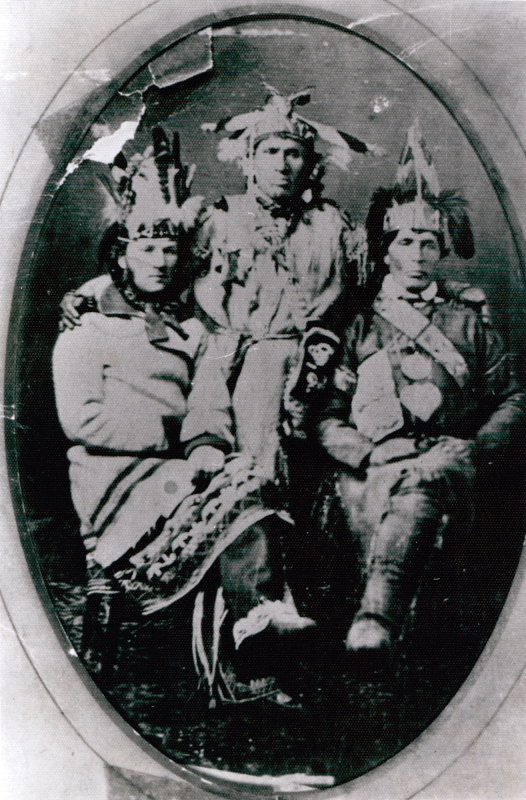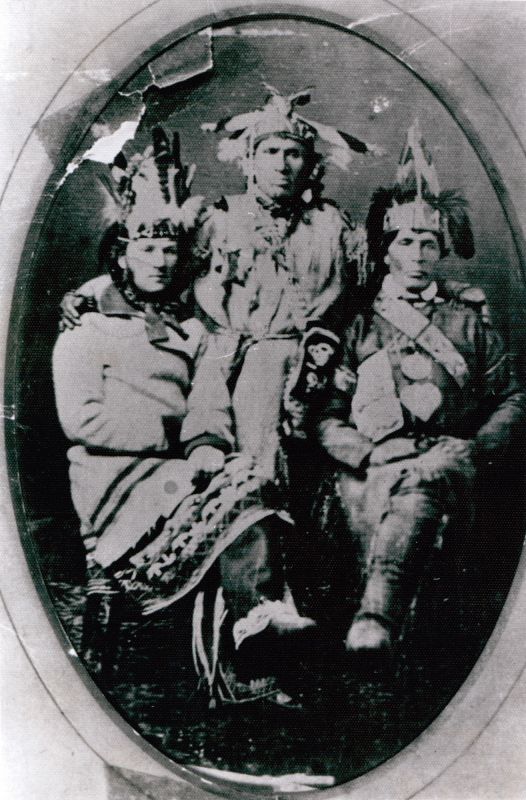Compiled by Sheila Wheesk and Bradley Clements, GRASAC Research Assistants

Image from Shingwauk Residential Schools Centre. P1.SHI.0.1.
Overview
Prior to the Robinson Huron Treaty, the Anishinaabek of the north shores of Lakes Superior and Lake Huron had been allies and trading partners with the French and later the British for more than two centuries.
Over the mid-1800s, a rapid settler population grew on the Canada/US border in the region due to its natural resources, land, and freshwater. In particular, miners began operating in these territories in contravention of the Royal Proclamation of 1763 and the Treaty of Niagara of 1764. As a result, Anishinaabe evicted some of the miners, and gimaak (chiefs) of these regions reminded the Province of Canada of the need to revisit their treaty relationship.
The Province of Canada’s Executive Council nominated William Benjamin Robinson to negotiate a treaty with the Anishinaabeg of the region on behalf of her Majesty the Queen (Gchi-Gimaakwe) on January 8, 1850. On January 11 Lord Elgin, the Governor General, seconded the Council’s recommendation for Robinson to become the treaty commissioner.
Robinson arrived on the north shore of Lake Superior to visit various communities during April and May of 1850, announcing his intentions. The official treaty negotiations were held on St. Mary’s Island in Sault Ste. Marie (Boweting), beginning in August. Lord Elgin joined Robinson on August 31. Some gimaak, such as Gimaa Shingwauk, disagreed with Canada’s limited offer and tried to negotiate improvements. However, other gimaak from north of Lake Superior were willing to sign the treaty. Due to this discrepancy, the Anishinabek of Lake Superior made a separate treaty with Robinson.
After negotiations with Lake Superior Anishinabek concluded, Robinson told the Lake Huron gimaak that their people would receive no compensation if they did not sign a treaty. As a result, the gimaak and Robinson signed the Robinson Huron Treaty at the HBC fort in Sault Ste. Marie on September 9, 1850. Anishinaabeg gimaak and principal men of that region marked an X on the treaty document.
Among Canada’s commitments in the Robinson Huron Treaty is an annual payment (“annuity”) to the Anishinaabeg of the region. The annuity was promised to increase “from time to time” along with revenues that Canada might receive from the treaty territory (an “escalator clause”), such as royalties from the mining and timbering operations. The Treaty also recognized continuing Anishinaabeg rights to fish, trap, gather, and hunt over unsettled treaty lands. Many of these commitments were not maintained by Canada, resulting in a long history of reminders and resistance from Anishinaabeg partners, including recent court cases.
Dates
- Preliminary discussions took place in April and May, 1850.
- Negotiations took place in August and early September, 1850.
- Treaty document signed on September 9, 1850.
Places
- Treaty negotiated on St. Mary’s Island, and treaty document signed at the HBC Fort in Sault Ste. Marie, Ontario.
- Treaty relates to Anishinaabeg territories north of Lake Huron.
Nations and Representatives
- Lake Huron Anishinaabeg nations
- Represented by various gimaak, including Gimaa Shingwauk and Gimaa Nebenaigooching
- Britain and Province of Canada
- Represented by Treaty Commissioner William B. Robinson and Governor General Lord Elgin
Negotiations
- Lands and resources.
- Annual payments, set to increase with revenues from the territories.
- Recognition of Anishinaabeg hunting, fishing, and harvesting rights.
Prior Negotiations
- Treaty of Niagara, 1764
- War of 1812 alliances
- Treaty of Manitowaning, 1836
- Robinson Superior Treaty, 1850
Subsequent Negotiations
- Manitoulin Island Treaty, 1862
- Restoule v. Canada, 2018
Sources
Heritage Items

Unknown artist. War club of Chief Shingwauk. Currently in the Royal Ontario Museum, 911.3.170. Item photographed and described as part of a GRASAC research trip December 2008; GRASAC item id 1044.

Unknown artist. Council War Club of Chief Shingwauk. Currently in the Royal Ontario Museum, 911.3.169. Item photographed and described as part of a GRASAC research trip December 2008; GRASAC item id 1567.

Unknown artist. Beaded garter of Chief Shingwauk. Currently in the Royal Ontario Museum, 987.261.47. Item photographed and described as part of a GRASAC research trip December 2008; GRASAC item id 1432.

Unknown artist. Pipe tomahawk of Chief Shingwauk. Currently in the Royal Ontario Museum, 911.3.174. Item photographed and described as part of a GRASAC research trip December 2008; GRASAC item id 1434.

Unknown Huron-Wendat artist. Hunting knife of Chief Shingwauk. Currently in the Royal Ontario Museum, 911.3.110 a, b. Item photographed and described as part of a GRASAC research trip December 2008; GRASAC item id 1540.

Unknown artist. Shoulder bag of Chief Shingwauk. Currently in the Royal Ontario Museum, 911.3.75. Item photographed and described as part of a GRASAC research trip December 2008; GRASAC item id 1039.

Shingwauk Residential Schools Centre. P1.SHI.0.1.
Language Items
- gimaa = chief, prime minister, boss, head
- animate noun
- GKS ID 15888
- gimaa = count somebody
- animate transitive verb
- GKS ID 15889
- gchi-gimaakwe = queen
- animate noun
- GKS ID 23953
- gchigmi = a great lake, e.g., Lake Michigan, Lake Huron
- inanimate noun, place
- GKS ID 23973
- Baawtigoong / Boweting = Sault Ste. Marie / The Rapids
- inanimate noun, place
- GKS ID 23780
- miinaa = give something to somebody
- animate transitive verb
- GKS ID 17916
- zhibii’gaaza = be written about, be written
- animate intransitive verb
- GKS ID 23568
- aazhdeyaakbii’ge = sign with a cross, sign with an X
- animate intransitive verb
- GKS ID 23537
- waawiindamaagewin = agreement
Primary Documents
- Robinson Huron Treaty – Surrender by the Ojibewa Indians inhabiting the North Shore of Lake Huron. Treaty document presented in image scan.
- Library and Archives Canada. RG 10, Vol. 1844/IT148, Microfilm reel number: T-9938.
- Digitized copy available through Library and Archives Canada: https://recherche-collection-search.bac-lac.gc.ca/eng/Home/Record?app=fonandcol&IdNumber=3963991&new=-8585976759098207836&wbdisable=true
Secondary Sources
Chute, Janet E. 2017. The Legacy of Shingwaukonse : A Century of Native Leadership. Toronto, Ontario: University of Toronto Press.
Hele, Karl S., ed. 2008. Lines Drawn upon the Water: First Nations and the Great Lakes Borders and Boarderlines. Waterloo, Ontario: Wilfrid Laurier University Press.
James, Morrison. 1996. The Robinson Treaties of 1850 : A Case Study. Royal Commission on Aboriginal Peoples. Hailybury Ontario: Canadian Government Publications.
Surtees, Robert J. 1986. Treaty Research Report: The Robinson Treaties 1850. Treaties and Historical Research Centre Indian and Northern Affairs Canada. https://www.rcaanc-cirnac.gc.ca/eng/1100100028974/1564412549270
More Sources
Robinson Huron Waawiindamaagewin. http://waawiindamaagewin.com/
- Robinson Huron Waawiindamaagewin is a collective governance body of Robinson Huron Treaty First Nations. Their website provides a central resource hub of extensive Anishinaabe-made resources about the Treaty, including videos, maps, events, and documents.
Anishinabek Nation of Ontario. Robinson-Huron Treaty Rights: 1850 and Today. https://www.anishinabek.ca/wp-content/uploads/2016/06/Robinson-Huron-Treaty-Rights.pdf
Brown, Lynne. 3 September 2017. “The Robinson Huron Treaty of 1850. 167 Years On.” Sault Online. https://saultonline.com/2017/09/the-robinson-huron-treaty-of-1850-167-years-on/
If you have information, events, or sources to add to this page, or if you would like to make a correction to it, please contact us by clicking here. Miigwetch, nia:wen, merci, thank you.
Return to the GRASAC Treaty Timeline.
